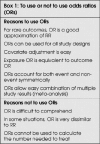What is so odd about odds?
Abstract
In clinical studies, the relative likelihood of an event occurring between 2 groups is often expressed as the risk ratio (RR) or the odds ratio (OR). The RR is an intuitive parameter that is relatively easy to interpret. Quantitative interpretation of an OR is much more difficult and is often incorrectly equated to that of an RR. The problem is that OR may differ substantially from RR, especially when the outcome of interest is common in the study population. This article explains and clarifies controversial issues surrounding the use and interpretation of the OR. Theoretical concepts relating to ORs are illustrated by examples from the surgical literature. By reviewing articles from 5 surgical journals over a 5-year period, we show that the OR is often presented and misinterpreted as equivalent to the RR. When the discrepancy is large, using OR uncritically as an estimate of RR will strongly bias inferences about treatment effect or cause of disease by amplifying the apparent strength of an association between an exposure and an outcome.
Dans les études cliniques, la probabilité relative d'occurrence d'un événement entre deux groupes est souvent exprimée sous forme de risque relatif (RR) ou de coefficient de probabilité (CP). Le RR est un paramètre intuitif relativement facile à interpréter. L'interprétation quantitative d'un CP est beaucoup plus difficile et on établit souvent à tort une équivalence avec celle d'un RR. Le problème, c'est que le CP peut différer considérablement du RR, particulièrement lorsque le résultat d'intérêt est commun dans la population à l'étude. Cet article explique et clarifie les enjeux controversés qui entourent l'utilisation et l'interprétation du CP. On illustre par des exemples tirés des documents sur la chirurgie les concepts reliés au CP. En critiquant des articles de cinq journaux chirurgicaux publiés sur une période de cinq ans, nous montrons que le CP est souvent présenté et interprété à tort comme l'équivalent du RR. Lorsque l'écart est important, l'utilisation du CP qu'on a critiqué comme estimation du RR biaisera fortement les déductions au sujet de l'effet du traitement ou de la cause d'une maladie en amplifiant la solidité apparente d'un lien entre une exposition et un résultat.
Figures




Similar articles
-
Relative risk and odds ratio data are still portrayed with inappropriate scales in the medical literature.J Clin Epidemiol. 2010 Sep;63(9):1045-7. doi: 10.1016/j.jclinepi.2009.12.016. Epub 2010 May 1. J Clin Epidemiol. 2010. PMID: 20435436
-
Technical note: The risk ratio, an alternative to the odds ratio for estimating the association between multiple risk factors and a dichotomous outcome.J Dairy Sci. 2012 May;95(5):2576-84. doi: 10.3168/jds.2011-4515. J Dairy Sci. 2012. PMID: 22541486
-
Odds ratios and risk ratios: what's the difference and why does it matter?South Med J. 2008 Jul;101(7):730-4. doi: 10.1097/SMJ.0b013e31817a7ee4. South Med J. 2008. PMID: 18580722
-
The (relative) risks of using odds ratios.Arch Dermatol. 2006 Jun;142(6):761-4. doi: 10.1001/archderm.142.6.761. Arch Dermatol. 2006. PMID: 16785380 Review.
-
Understanding the odds ratio and the relative risk.J Androl. 2001 Jul-Aug;22(4):533-6. J Androl. 2001. PMID: 11451349 Review.
Cited by
-
Birth order, sibship size, and risk of atopic dermatitis, food allergy, and atopy: A systematic review and meta-analysis.Clin Transl Allergy. 2023 Jun;13(6):e12270. doi: 10.1002/clt2.12270. Clin Transl Allergy. 2023. PMID: 37357553 Free PMC article. Review.
-
Is sibship composition a risk factor for childhood asthma? Systematic review and meta-analysis.World J Pediatr. 2023 Dec;19(12):1127-1138. doi: 10.1007/s12519-023-00706-w. Epub 2023 Mar 30. World J Pediatr. 2023. PMID: 36997765 Free PMC article. Review.
-
Status of Household Solid Waste Management and Associated Factors in a Slum Community in Kampala, Uganda.J Environ Public Health. 2020 May 6;2020:6807630. doi: 10.1155/2020/6807630. eCollection 2020. J Environ Public Health. 2020. PMID: 32454842 Free PMC article.
-
Characteristics of sanitation and hygiene facilities in a slum community in Kampala, Uganda.Int Health. 2021 Jan 14;13(1):13-21. doi: 10.1093/inthealth/ihaa011. Int Health. 2021. PMID: 32236413 Free PMC article.
-
Early versus delayed hormonal treatment in locally advanced or asymptomatic metastatic prostatic cancer patient dilemma.World J Urol. 2014 Jun;32(3):661-7. doi: 10.1007/s00345-013-1144-x. Epub 2013 Aug 8. World J Urol. 2014. PMID: 23925365
References
-
- Guller U, DeLong ER. Interpreting statistics in medical literature: a vade mecum for surgeons. J Am Coll Surg 2004;198:441-58. - PubMed
-
- Berwick DM, Fineberg HV, Weinstein MC. When doctors meet numbers. Am J Med 1981;71:991-8. - PubMed
-
- Hennekens CH, Buring JE. Epidemiology in medicine. Boston: Little, Brown; 1987.
MeSH terms
LinkOut - more resources
Full Text Sources
